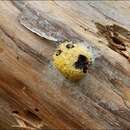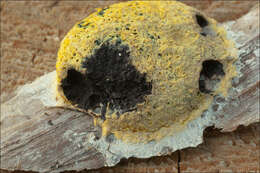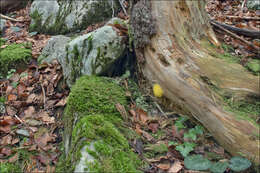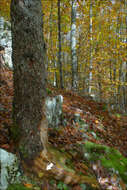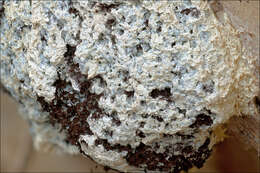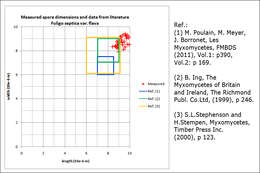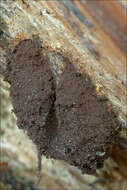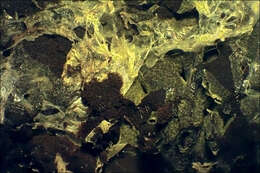-
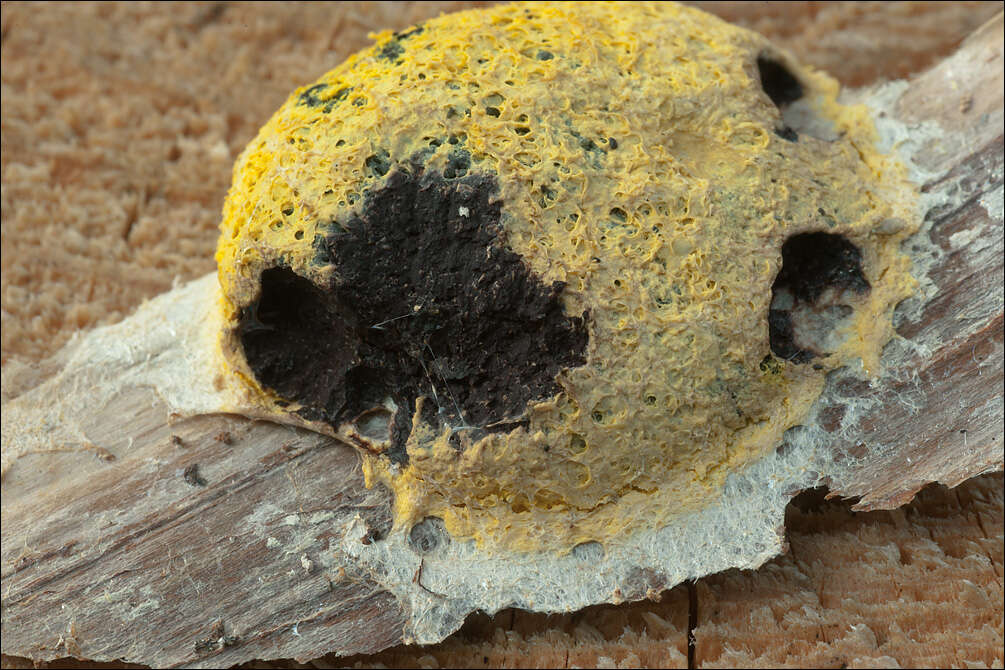
Fuligo septica var. flava (Pers.) Morgan, syn.: Mucor septicus L., Aethalium flavum (Pers) LinkFlowers of Tan, DE: Gelbe LohblteSlo.: reslov cvet, rumeni razliekDat.: Sept. 05. 2014Lat.: 46.35965 Long.: 13.70116Code: Bot_832/2014_DSC3621Habitat: mixed wood, Fagus sylvatica and Picea abies dominant, moderately southeast inclined mountain slope, shallow, skeletal calcareous ground, old overgrown slope and moraine scree with larger rocks and boulders, in shade, relatively warm place, partly protected from direct rain by tree canopies, average precipitation ~ 3.000 mm/year, average temperature 7 - 9 deg C, elevation 600 m (1.970 feet), alpine phytogeographical region. Substratum: debarked trunk of Picea abies lying on ground in its late disintegration stage.Place: Lower Trenta valley, between villages Soa and Trenta, next to the trail from Trenta 2b cottage to abandoned farmhouse 'Strgulc', East Julian Alps, Posoje, Slovenia EC.Comment: Fuligo septica is probably the most common and widely known Myxomicete. The latest monograph on Myxomycetes I have (Ref.:1) describes six varieties of this species, which differ mostly in cortex structure (single versus double layered) and color of different parts of sporocarp and plasmodium. Fuligo septica var. flava should have vivid yellow aethalia, yellow inner lime and yellow plasmodium. Two days before I took these pictures I had seen the plasmodium, which was in a form of vividly yellow colored patch of densely packed small half-spheres. The rest of traits of Fuligo septica var. flava also fit well to my observation.Spores minutely warty, globose to subglobose. Dimensions: 8 [8,4 ; 8,7] 9,1 x 7,4 [8 ; 8,2] 8,7 microns; Q = [1 ; 1,07] 1,1; N = 25; C = 95%; Me = 8,5 x 8,1 microns; Qe = 1,1. Olympus CH20, NEA 100x/1.25, magnification 1.000 x, oil (spores), NEA 40x/0.65, magnification 400x (capillitium, calcareous granules); in water; live material. AmScope MA500 digital camera.Herbarium: Mycotheca and lichen herbarium (LJU-Li) of Slovenian Forestry Institute, Vena pot 2, Ljubljana, Index Herbariorum LJFRef.:(1) M. Poulain, M. Meyer, J. Borronet, Les Myxomycetes, FMBDS (2011), Vol.1: p390, Vol.2: (2) B. Ing, The Myxomycetes of Britain and Ireland, The Richmond Publ. Co.Ltd, (1999), p 246. (3) S.L.Stephenson and H.Stempen, Myxomycetes, Timber Press Inc.(2000), p 123.
-
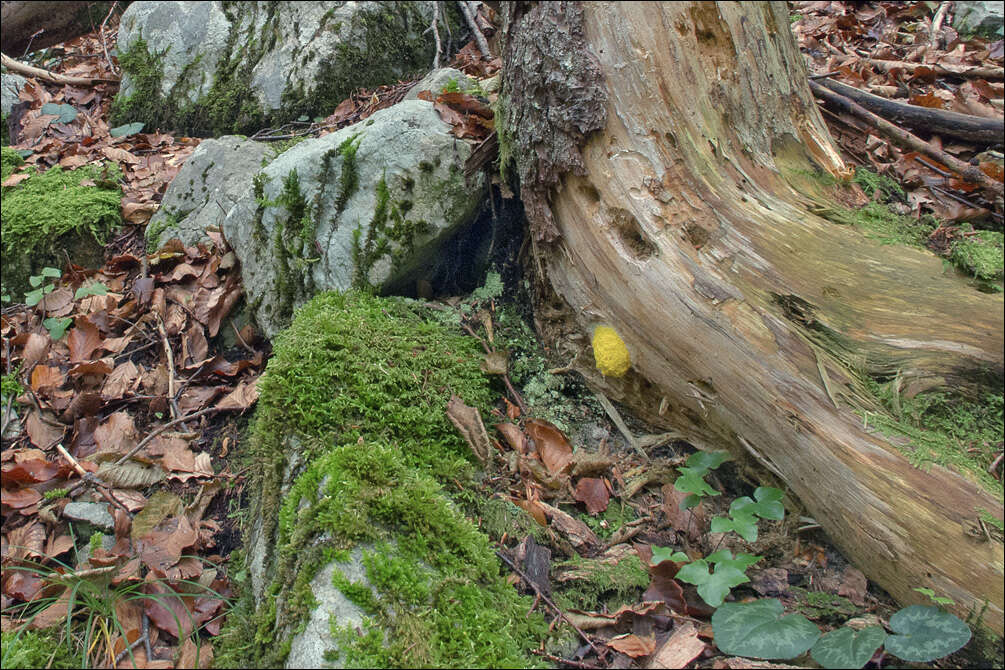
Fuligo septica var. flava (Pers.) Morgan, syn.: Mucor septicus L., Aethalium flavum (Pers) LinkFlowers of Tan, DE: Gelbe LohblteSlo.: reslov cvet, rumeni razliekDat.: Oct. 17. 2016Lat.: 46.35977 Long.: 13.70137Code:Bot_1019/2016_DSC5774Habitat: mixed wood, Fagus sylvatica and Picea abies dominant, moderately southeast inclined mountain slope, shallow, skeletal calcareous ground, old overgrown slope and moraine scree with larger rocks and boulders, in shade, relatively warm place, partly protected from direct rain by tree canopies, average precipitation ~ 3.000 mm/year, average temperature 7 - 9 deg C, elevation 600 m (1.970 feet), alpine phytogeographical region. Substratum: debarked roots of dead Picea abies, still standing.Place: Lower Trenta valley, between villages Soa and Trenta, next to the trail from Trenta 2b cottage to abandoned farmhouse 'Strgulc', East Julian Alps, Posoje, Slovenia EC.Comment: Fuligo septica is probably the most common and widely known Myxomicete. One of its varieties - Fuligo septica var. flava - has vivid yellow aethalia and yellow plasmodium (I haven't seen it this time). Yet, this typical color pertains only to mature but still fresh aethalia (pictures 10-13). With time cortex becomes darker, almost golden (picture 14), then black inside becomes visible (pictures 15, 16). In next phase cortex become whitish (pictures 17, 18) and finally it disappears and only blackish-reddish-brown spore mass is seen (pictures 19, 20). It is interesting that this find was found only a few meters away of the site where I photographed the same species two years ago (see Album Fuligo septica var. flava - I, Dec. 2014) (see MO observations #194527). In both observations spores are unusually large.Spores minutely warty, globose to subglobose. Dimensions: 8,5 [9,1 ; 9,4] 10 x 8 [8,6 ; 8,8] 9,4 microns; Q = [1 ; 1,08] 1,1; N = 35; C = 95%; Me = 9,2 x 8,7 microns; Qe = 1,1. Olympus CH20, NEA 100x/1.25, magnification 1.000 x, oil, in water; fresh material. AmScope MA500 digital camera.Herbarium: Mycotheca and lichen herbarium (LJU-Li) of Slovenian Forestry Institute, Vena pot 2, Ljubljana, Index Herbariorum LJFRef.:(1) M. Poulain, M. Meyer, J. Borronet, Les Myxomycetes, FMBDS (2011), Vol.1: p390, Vol.2: p 169.(2) B. Ing, The Myxomycetes of Britain and Ireland, The Richmond Publ. Co.Ltd, (1999), p 246. (3) S.L.Stephenson and H.Stempen, Myxomycetes, Timber Press Inc.(2000), p 123.
-
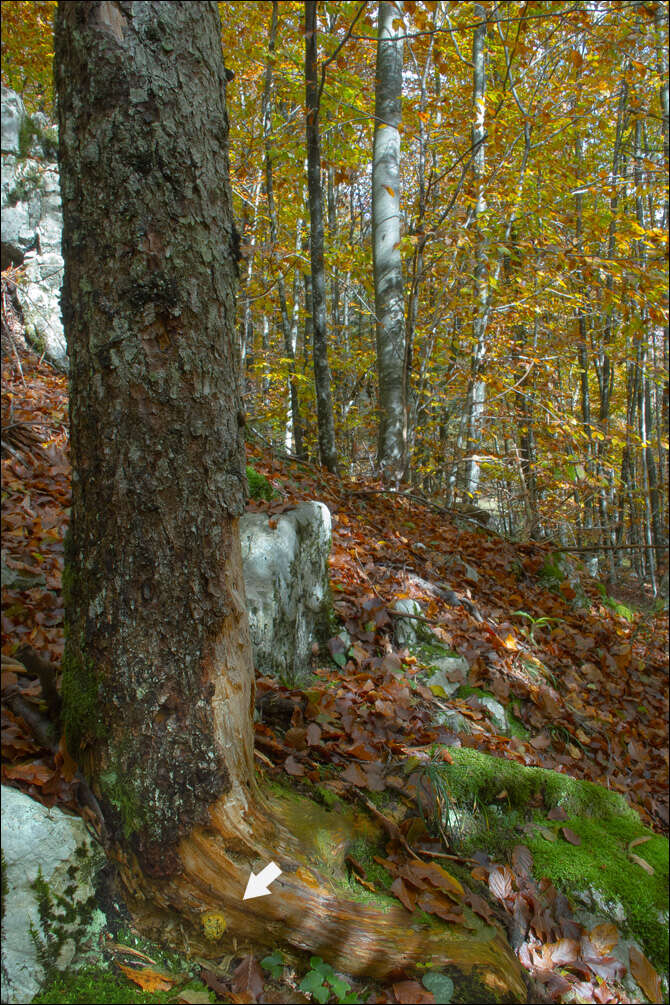
Fuligo septica var. flava (Pers.) Morgan, syn.: Mucor septicus L., Aethalium flavum (Pers) LinkFlowers of Tan, DE: Gelbe LohblteSlo.: reslov cvet, rumeni razliekDat.: Oct. 26. 2016Lat.: 46.35977 Long.: 13.70137Code: Bot_1022/2016_DSC6083Habitat: mixed wood, Fagus sylvatica and Picea abies dominant, moderately southeast inclined mountain slope, shallow, skeletal calcareous ground, old overgrown slope and moraine scree with larger rocks and boulders, in shade, relatively warm place, partly protected from direct rain by tree canopies, average precipitation ~ 3.000 mm/year, average temperature 7 - 9 deg C, elevation 600 m (1.970 feet), alpine phytogeographical region. Substratum: debarked roots of dead Picea abies, still standing.Place: Lower Trenta valley, between villages Soa and Trenta, next to the trail from Trenta 2b cottage to abandoned farmhouse 'Strgulc', East Julian Alps, Posoje, Slovenia EC.Comment: Fuligo septica is probably the most common and widely known Myxomicete. One of its varieties - Fuligo septica var. flava - has vivid yellow aethalia and yellow plasmodium (I haven't seen it this time). Yet, this typical color pertains only to mature but still fresh aethalia (pictures 10-13). With time cortex becomes darker, almost golden (picture 14), then black inside becomes visible (pictures 15, 16). In next phase cortex become whitish (pictures 17, 18) and finally it disappears and only blackish-reddish-brown spore mass is seen (pictures 19, 20). It is interesting that this find was found only a few meters away of the site where I photographed the same species two years ago (see Album Fuligo septica var. flava - I, Dec. 2014) (see MO observations #194527). In both observations spores are unusually large.Spores minutely warty, globose to subglobose. Dimensions: 8,5 [9,1 ; 9,4] 10 x 8 [8,6 ; 8,8] 9,4 microns; Q = [1 ; 1,08] 1,1; N = 35; C = 95%; Me = 9,2 x 8,7 microns; Qe = 1,1. Olympus CH20, NEA 100x/1.25, magnification 1.000 x, oil, in water; fresh material. AmScope MA500 digital camera.Herbarium: Mycotheca and lichen herbarium (LJU-Li) of Slovenian Forestry Institute, Vena pot 2, Ljubljana, Index Herbariorum LJFRef.:(1) M. Poulain, M. Meyer, J. Borronet, Les Myxomycetes, FMBDS (2011), Vol.1: p390, Vol.2: p 169.(2) B. Ing, The Myxomycetes of Britain and Ireland, The Richmond Publ. Co.Ltd, (1999), p 246. (3) S.L.Stephenson and H.Stempen, Myxomycetes, Timber Press Inc.(2000), p 123.
-
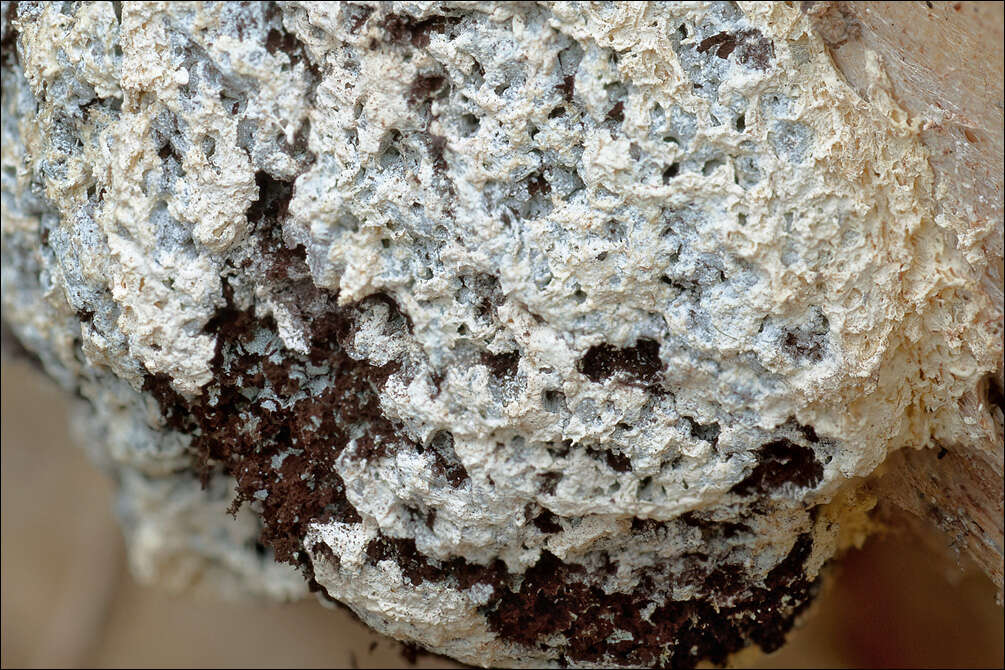
Fuligo septica var. flava (Pers.) Morgan, syn.: Mucor septicus L., Aethalium flavum (Pers) LinkFlowers of Tan, DE: Gelbe LohblteSlo.: reslov cvet, rumeni razliekDat.: Nov. 02. 2016Lat.: 46.35977 Long.: 13.70137Code: Bot_1025/2016_DSC6323Habitat: mixed wood, Fagus sylvatica and Picea abies dominant, moderately southeast inclined mountain slope, shallow, skeletal calcareous ground, old overgrown slope and moraine scree with larger rocks and boulders, in shade, relatively warm place, partly protected from direct rain by tree canopies, average precipitation ~ 3.000 mm/year, average temperature 7 - 9 deg C, elevation 600 m (1.970 feet), alpine phytogeographical region. Substratum: debarked roots of dead Picea abies, still standing.Place: Lower Trenta valley, between villages Soa and Trenta, next to the trail from Trenta 2b cottage to abandoned farmhouse 'Strgulc', East Julian Alps, Posoje, Slovenia EC.Comment: Fuligo septica is probably the most common and widely known Myxomicete. One of its varieties - Fuligo septica var. flava - has vivid yellow aethalia and yellow plasmodium (I haven't seen it this time). Yet, this typical color pertains only to mature but still fresh aethalia (pictures 10-13). With time cortex becomes darker, almost golden (picture 14), then black inside becomes visible (pictures 15, 16). In next phase cortex become whitish (pictures 17, 18) and finally it disappears and only blackish-reddish-brown spore mass is seen (pictures 19, 20). It is interesting that this find was found only a few meters away of the site where I photographed the same species two years ago (see Album Fuligo septica var. flava - I, Dec. 2014) (see MO observations #194527). In both observations spores are unusually large.Spores minutely warty, globose to subglobose. Dimensions: 8,5 [9,1 ; 9,4] 10 x 8 [8,6 ; 8,8] 9,4 microns; Q = [1 ; 1,08] 1,1; N = 35; C = 95%; Me = 9,2 x 8,7 microns; Qe = 1,1. Olympus CH20, NEA 100x/1.25, magnification 1.000 x, oil, in water; fresh material. AmScope MA500 digital camera.Herbarium: Mycotheca and lichen herbarium (LJU-Li) of Slovenian Forestry Institute, Vena pot 2, Ljubljana, Index Herbariorum LJFRef.:(1) M. Poulain, M. Meyer, J. Borronet, Les Myxomycetes, FMBDS (2011), Vol.1: p390, Vol.2: p 169.(2) B. Ing, The Myxomycetes of Britain and Ireland, The Richmond Publ. Co.Ltd, (1999), p 246. (3) S.L.Stephenson and H.Stempen, Myxomycetes, Timber Press Inc.(2000), p 123.
-
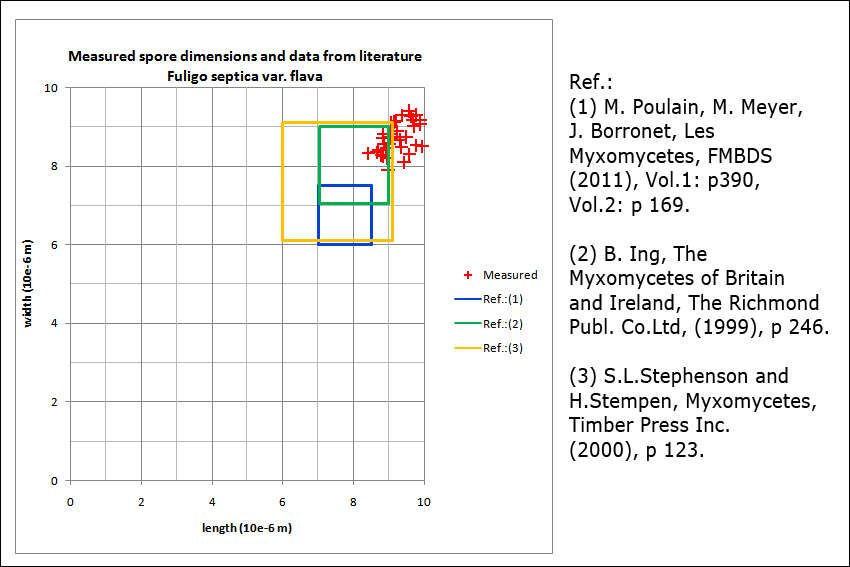
Fuligo septica var. flava (Pers.) Morgan, syn.: Mucor septicus L., Aethalium flavum (Pers) LinkFlowers of Tan, DE: Gelbe LohblteSlo.: reslov cvet, rumeni razliekDat.: Nov. 08. 2016Lat.: 46.35977 Long.: 13.70137Code: Bot_1027/2016_DSC6404Habitat: mixed wood, Fagus sylvatica and Picea abies dominant, moderately southeast inclined mountain slope, shallow, skeletal calcareous ground, old overgrown slope and moraine scree with larger rocks and boulders, in shade, relatively warm place, partly protected from direct rain by tree canopies, average precipitation ~ 3.000 mm/year, average temperature 7 - 9 deg C, elevation 600 m (1.970 feet), alpine phytogeographical region. Substratum: debarked roots of dead Picea abies, still standing.Place: Lower Trenta valley, between villages Soa and Trenta, next to the trail from Trenta 2b cottage to abandoned farmhouse 'Strgulc', East Julian Alps, Posoje, Slovenia EC.Comment: Fuligo septica is probably the most common and widely known Myxomicete. One of its varieties - Fuligo septica var. flava - has vivid yellow aethalia and yellow plasmodium (I haven't seen it this time). Yet, this typical color pertains only to mature but still fresh aethalia (pictures 10-13). With time cortex becomes darker, almost golden (picture 14), then black inside becomes visible (pictures 15, 16). In next phase cortex become whitish (pictures 17, 18) and finally it disappears and only blackish-reddish-brown spore mass is seen (pictures 19, 20). It is interesting that this find was found only a few meters away of the site where I photographed the same species two years ago (see Album Fuligo septica var. flava - I, Dec. 2014) (see MO observations #194527). In both observations spores are unusually large.Spores minutely warty, globose to subglobose. Dimensions: 8,5 [9,1 ; 9,4] 10 x 8 [8,6 ; 8,8] 9,4 microns; Q = [1 ; 1,08] 1,1; N = 35; C = 95%; Me = 9,2 x 8,7 microns; Qe = 1,1. Olympus CH20, NEA 100x/1.25, magnification 1.000 x, oil, in water; fresh material. AmScope MA500 digital camera.Herbarium: Mycotheca and lichen herbarium (LJU-Li) of Slovenian Forestry Institute, Vena pot 2, Ljubljana, Index Herbariorum LJFRef.:(1) M. Poulain, M. Meyer, J. Borronet, Les Myxomycetes, FMBDS (2011), Vol.1: p390, Vol.2: p 169.(2) B. Ing, The Myxomycetes of Britain and Ireland, The Richmond Publ. Co.Ltd, (1999), p 246. (3) S.L.Stephenson and H.Stempen, Myxomycetes, Timber Press Inc.(2000), p 123.
-
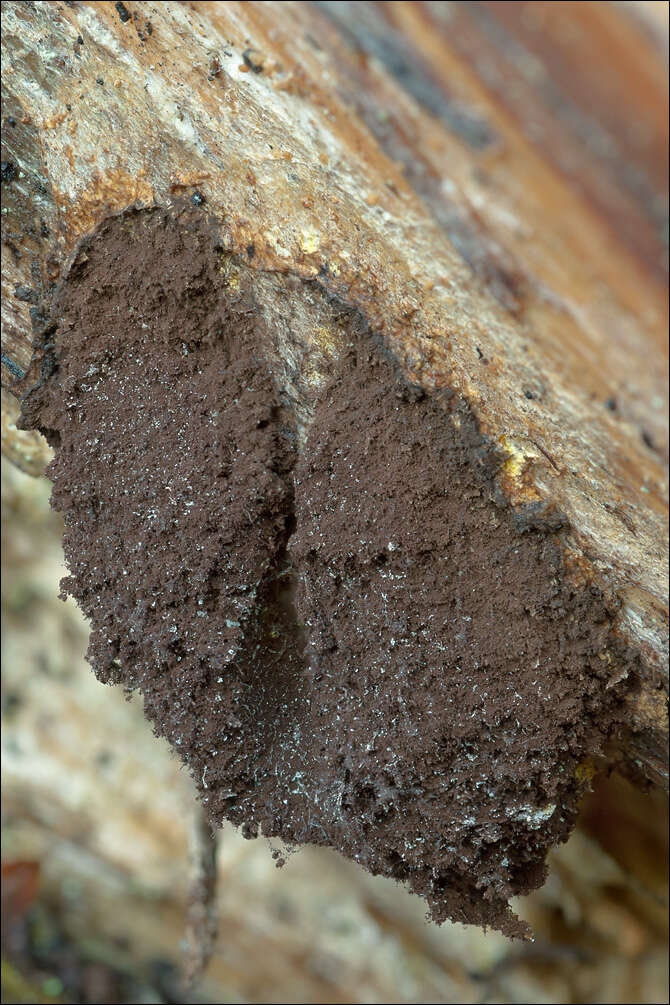
Fuligo septica var. flava (Pers.) Morgan, syn.: Mucor septicus L., Aethalium flavum (Pers) LinkFlowers of Tan, DE: Gelbe LohblteSlo.: reslov cvet, rumeni razliekDat.: Nov. 08. 2016Lat.: 46.35977 Long.: 13.70137Code: Bot_1027/2016_DSC6404Habitat: mixed wood, Fagus sylvatica and Picea abies dominant, moderately southeast inclined mountain slope, shallow, skeletal calcareous ground, old overgrown slope and moraine scree with larger rocks and boulders, in shade, relatively warm place, partly protected from direct rain by tree canopies, average precipitation ~ 3.000 mm/year, average temperature 7 - 9 deg C, elevation 600 m (1.970 feet), alpine phytogeographical region. Substratum: debarked roots of dead Picea abies, still standing.Place: Lower Trenta valley, between villages Soa and Trenta, next to the trail from Trenta 2b cottage to abandoned farmhouse 'Strgulc', East Julian Alps, Posoje, Slovenia EC.Comment: Fuligo septica is probably the most common and widely known Myxomicete. One of its varieties - Fuligo septica var. flava - has vivid yellow aethalia and yellow plasmodium (I haven't seen it this time). Yet, this typical color pertains only to mature but still fresh aethalia (pictures 10-13). With time cortex becomes darker, almost golden (picture 14), then black inside becomes visible (pictures 15, 16). In next phase cortex become whitish (pictures 17, 18) and finally it disappears and only blackish-reddish-brown spore mass is seen (pictures 19, 20). It is interesting that this find was found only a few meters away of the site where I photographed the same species two years ago (see Album Fuligo septica var. flava - I, Dec. 2014) (see MO observations #194527). In both observations spores are unusually large.Spores minutely warty, globose to subglobose. Dimensions: 8,5 [9,1 ; 9,4] 10 x 8 [8,6 ; 8,8] 9,4 microns; Q = [1 ; 1,08] 1,1; N = 35; C = 95%; Me = 9,2 x 8,7 microns; Qe = 1,1. Olympus CH20, NEA 100x/1.25, magnification 1.000 x, oil, in water; fresh material. AmScope MA500 digital camera.Herbarium: Mycotheca and lichen herbarium (LJU-Li) of Slovenian Forestry Institute, Vena pot 2, Ljubljana, Index Herbariorum LJFRef.:(1) M. Poulain, M. Meyer, J. Borronet, Les Myxomycetes, FMBDS (2011), Vol.1: p390, Vol.2: p 169.(2) B. Ing, The Myxomycetes of Britain and Ireland, The Richmond Publ. Co.Ltd, (1999), p 246. (3) S.L.Stephenson and H.Stempen, Myxomycetes, Timber Press Inc.(2000), p 123.
-

Fuligo septica var. flava (Pers.) Morgan, syn.: Mucor septicus L., Aethalium flavum (Pers) LinkFlowers of Tan, DE: Gelbe LohblteSlo.: reslov cvet, rumeni razliekDat.: Sept. 05. 2014Lat.: 46.35965 Long.: 13.70116Code: Bot_832/2014_DSC3621Habitat: mixed wood, Fagus sylvatica and Picea abies dominant, moderately southeast inclined mountain slope, shallow, skeletal calcareous ground, old overgrown slope and moraine scree with larger rocks and boulders, in shade, relatively warm place, partly protected from direct rain by tree canopies, average precipitation ~ 3.000 mm/year, average temperature 7 - 9 deg C, elevation 600 m (1.970 feet), alpine phytogeographical region. Substratum: debarked trunk of Picea abies lying on ground in its late disintegration stage.Place: Lower Trenta valley, between villages Soa and Trenta, next to the trail from Trenta 2b cottage to abandoned farmhouse 'Strgulc', East Julian Alps, Posoje, Slovenia EC.Comment: Fuligo septica is probably the most common and widely known Myxomicete. The latest monograph on Myxomycetes I have (Ref.:1) describes six varieties of this species, which differ mostly in cortex structure (single versus double layered) and color of different parts of sporocarp and plasmodium. Fuligo septica var. flava should have vivid yellow aethalia, yellow inner lime and yellow plasmodium. Two days before I took these pictures I had seen the plasmodium, which was in a form of vividly yellow colored patch of densely packed small half-spheres. The rest of traits of Fuligo septica var. flava also fit well to my observation.Spores minutely warty, globose to subglobose. Dimensions: 8 [8,4 ; 8,7] 9,1 x 7,4 [8 ; 8,2] 8,7 microns; Q = [1 ; 1,07] 1,1; N = 25; C = 95%; Me = 8,5 x 8,1 microns; Qe = 1,1. Olympus CH20, NEA 100x/1.25, magnification 1.000 x, oil (spores), NEA 40x/0.65, magnification 400x (capillitium, calcareous granules); in water; live material. AmScope MA500 digital camera.Herbarium: Mycotheca and lichen herbarium (LJU-Li) of Slovenian Forestry Institute, Vena pot 2, Ljubljana, Index Herbariorum LJFRef.:(1) M. Poulain, M. Meyer, J. Borronet, Les Myxomycetes, FMBDS (2011), Vol.1: p390, Vol.2: (2) B. Ing, The Myxomycetes of Britain and Ireland, The Richmond Publ. Co.Ltd, (1999), p 246. (3) S.L.Stephenson and H.Stempen, Myxomycetes, Timber Press Inc.(2000), p 123.
-
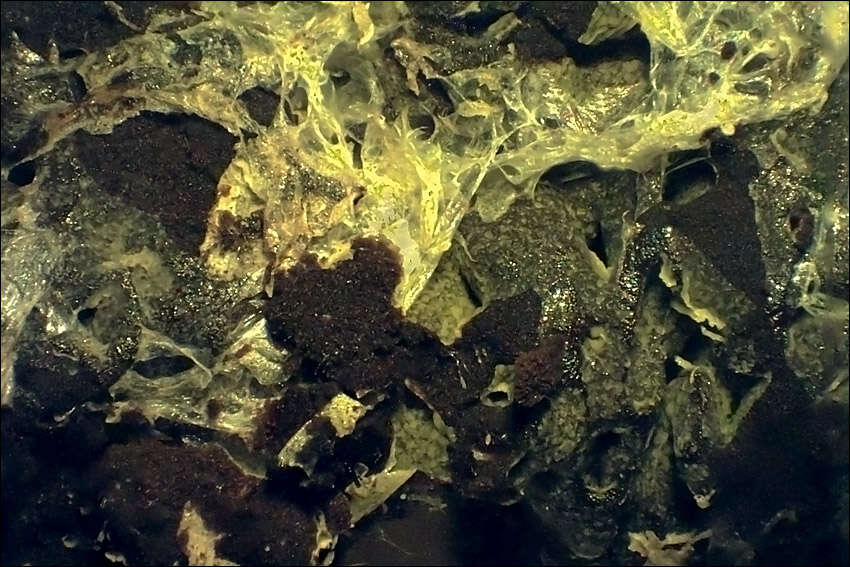
Fuligo septica var. flava (Pers.) Morgan, syn.: Mucor septicus L., Aethalium flavum (Pers) LinkFlowers of Tan, DE: Gelbe LohblteSlo.: reslov cvet, rumeni razliekDat.: Sept. 05. 2014Lat.: 46.35965 Long.: 13.70116Code: Bot_832/2014_DSC3621Habitat: mixed wood, Fagus sylvatica and Picea abies dominant, moderately southeast inclined mountain slope, shallow, skeletal calcareous ground, old overgrown slope and moraine scree with larger rocks and boulders, in shade, relatively warm place, partly protected from direct rain by tree canopies, average precipitation ~ 3.000 mm/year, average temperature 7 - 9 deg C, elevation 600 m (1.970 feet), alpine phytogeographical region. Substratum: debarked trunk of Picea abies lying on ground in its late disintegration stage.Place: Lower Trenta valley, between villages Soa and Trenta, next to the trail from Trenta 2b cottage to abandoned farmhouse 'Strgulc', East Julian Alps, Posoje, Slovenia EC.Comment: Fuligo septica is probably the most common and widely known Myxomicete. The latest monograph on Myxomycetes I have (Ref.:1) describes six varieties of this species, which differ mostly in cortex structure (single versus double layered) and color of different parts of sporocarp and plasmodium. Fuligo septica var. flava should have vivid yellow aethalia, yellow inner lime and yellow plasmodium. Two days before I took these pictures I had seen the plasmodium, which was in a form of vividly yellow colored patch of densely packed small half-spheres. The rest of traits of Fuligo septica var. flava also fit well to my observation.Spores minutely warty, globose to subglobose. Dimensions: 8 [8,4 ; 8,7] 9,1 x 7,4 [8 ; 8,2] 8,7 microns; Q = [1 ; 1,07] 1,1; N = 25; C = 95%; Me = 8,5 x 8,1 microns; Qe = 1,1. Olympus CH20, NEA 100x/1.25, magnification 1.000 x, oil (spores), NEA 40x/0.65, magnification 400x (capillitium, calcareous granules); in water; live material. AmScope MA500 digital camera.Herbarium: Mycotheca and lichen herbarium (LJU-Li) of Slovenian Forestry Institute, Vena pot 2, Ljubljana, Index Herbariorum LJFRef.:(1) M. Poulain, M. Meyer, J. Borronet, Les Myxomycetes, FMBDS (2011), Vol.1: p390, Vol.2: (2) B. Ing, The Myxomycetes of Britain and Ireland, The Richmond Publ. Co.Ltd, (1999), p 246. (3) S.L.Stephenson and H.Stempen, Myxomycetes, Timber Press Inc.(2000), p 123.
-
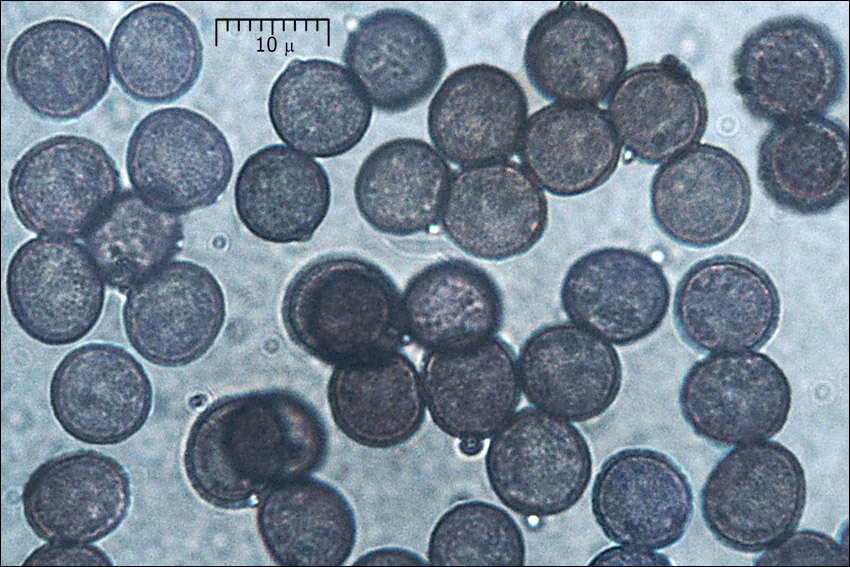
Fuligo septica var. flava (Pers.) Morgan, syn.: Mucor septicus L., Aethalium flavum (Pers) LinkFlowers of Tan, DE: Gelbe LohblteSlo.: reslov cvet, rumeni razliekDat.: Nov. 08. 2016Lat.: 46.35977 Long.: 13.70137Code: Bot_1027/2016_DSC6404Habitat: mixed wood, Fagus sylvatica and Picea abies dominant, moderately southeast inclined mountain slope, shallow, skeletal calcareous ground, old overgrown slope and moraine scree with larger rocks and boulders, in shade, relatively warm place, partly protected from direct rain by tree canopies, average precipitation ~ 3.000 mm/year, average temperature 7 - 9 deg C, elevation 600 m (1.970 feet), alpine phytogeographical region. Substratum: debarked roots of dead Picea abies, still standing.Place: Lower Trenta valley, between villages Soa and Trenta, next to the trail from Trenta 2b cottage to abandoned farmhouse 'Strgulc', East Julian Alps, Posoje, Slovenia EC.Comment: Fuligo septica is probably the most common and widely known Myxomicete. One of its varieties - Fuligo septica var. flava - has vivid yellow aethalia and yellow plasmodium (I haven't seen it this time). Yet, this typical color pertains only to mature but still fresh aethalia (pictures 10-13). With time cortex becomes darker, almost golden (picture 14), then black inside becomes visible (pictures 15, 16). In next phase cortex become whitish (pictures 17, 18) and finally it disappears and only blackish-reddish-brown spore mass is seen (pictures 19, 20). It is interesting that this find was found only a few meters away of the site where I photographed the same species two years ago (see Album Fuligo septica var. flava - I, Dec. 2014) (see MO observations #194527). In both observations spores are unusually large.Spores minutely warty, globose to subglobose. Dimensions: 8,5 [9,1 ; 9,4] 10 x 8 [8,6 ; 8,8] 9,4 microns; Q = [1 ; 1,08] 1,1; N = 35; C = 95%; Me = 9,2 x 8,7 microns; Qe = 1,1. Olympus CH20, NEA 100x/1.25, magnification 1.000 x, oil, in water; fresh material. AmScope MA500 digital camera.Herbarium: Mycotheca and lichen herbarium (LJU-Li) of Slovenian Forestry Institute, Vena pot 2, Ljubljana, Index Herbariorum LJFRef.:(1) M. Poulain, M. Meyer, J. Borronet, Les Myxomycetes, FMBDS (2011), Vol.1: p390, Vol.2: p 169.(2) B. Ing, The Myxomycetes of Britain and Ireland, The Richmond Publ. Co.Ltd, (1999), p 246. (3) S.L.Stephenson and H.Stempen, Myxomycetes, Timber Press Inc.(2000), p 123.

